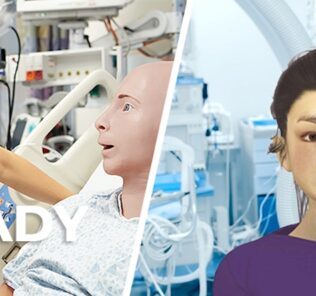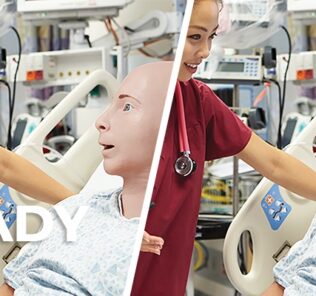Next-Gen Technology to Help the Next Generation
We need to Be READY to help teens in crises. Worldwide, there are almost 1.3 billion adolescents between the ages of 10 and 19, of which 42 million are in the U.S. They represent a specific group with distinct challenges. Understanding and preparing for these specific needs will allow healthcare workers across the globe help adolescents and teens in crises. And they are needing help. The Centers for Disease Control (CDC) says 16-18% of adolescents had 1 or more emergency department (ED) visits yearly. That’s at least 6.5 million ED visits every year in the U.S. alone. The numbers may vary from country to country, but the reality is the same – teens are in EDs in large numbers.
But why are teens in the ED? Falls and unintentional injuries account for about 40% of ED visits. But beyond these, other causes are more specific.
Accidents: Motor vehicle accidents is the second highest cause of teens at the ED – amounting to 10 percent of teen visits. In 2019, almost 258,000 teens were treated in EDs for injuries suffered in car crashes. Every single day almost seven teens die due to road accidents. Proper Assessment and Triage for these patients could effectively help prevent more serious injuries, preserving limbs and even more importantly help saving lives.
Sponsored Content:
Mental Health: Mental Health America says one in 10 youth are experiencing depression and one in six teenagers has a major depressive episode (MDE) needing treatment at the ED every year. The CDC reports that, in 2020, there was a 31% increase in mental health–related ED visits for teenagers compared to the previous year. These patients need support from healthcare workers who are well-experienced in first aid care so that they may provide mental health support while simultaneously attending to physical well-being.
Self-Harm and Suicide: Teen suicide is a big concern. The CDC says 19 percent of teenagers have ‘seriously considered’ it in the past year, 16 percent made a suicide plan, nine percent attempted suicide, and three percent needed medical treatment for a suicide attempt. The situation was exacerbated by the COVID-19 pandemic, especially in girls. Between February and March of 2021, attempted suicide rates increased by 51 percent for teen girls. Emergency Medical Technicians (EMTs) and other first responders are often left to assess, treat and save these patients with little to no specific training with teenage patients.
Substance Abuse: Alcohol, marijuana, and tobacco are the most abused substances by teens. Six percent of American youth – that’s over 1.5 million – reported a substance use disorder each year. Misuse of prescription pain relievers (396,000 cases/year) and hallucinogens (370,000 cases/year) are high among teenagers. Frequently, drug overdose cases end up at the ED. The first goal is to rescue the patient’s health. The long-term goal is to support the teenager in their path to recovery. But successful entry to rehabilitation often depends on how overdose patients are cared for at the point of care. To deliver effective care, healthcare workers need specialized training geared toward teenage patients.
Sexual Assault: Statistics paint a grim picture. 4.2 percent of all assault victims requiring medical treatment are victims of sexual assault. In a six year period, nearly 21,000 teenagers were admitted to EDs as confirmed sexual abuse victims and ED admissions for adolescent sexual abuse doubled from the start to the end of this period. Medical treatment, trauma care, psychological support and evidence collection needs to be done carefully and correctly. And doing all this under pressure, to a traumatized teenager, at the point of care is not an instinctive skill learned from experience. Treating a teenage sexual assault victim appropriately is critical for their well-being, for justice, and for their rehabilitation.
Sponsored Content:
What Do We Need to Help Teens in Crises?
Protocols: Triage and treatment protocols do exist, but these are often made for adult or pediatric needs. Yes, teens are either children or adults and treated medically as such. But in situations of substance abuse, self-harm, mental health crises, treating teens as an adult or a child is not the best practice. There is value in developing protocols specifically for teens. These will provide clear guidelines for first responders and EMTs instead of depending on their situational assessment. Protocols allow frontline healthcare workers to use their valuable minutes administering treatment as opposed to deciding which form of treatment to administer.
Training: Protocols do not improve patient outcome simply by existing. They are useful only if healthcare workers are trained on following them. We need to educate first responders on the most common teen crisis scenarios. Then train them to handle complex situations, often a mix of physical trauma and mental health issues. Healthcare workers need to practice on teen-specific scenarios, in the classroom, in the field, and in the hospital. For this, they need realistic teenage simulators, not embodied in either adult or pediatric manikins.
Simulators: Existing adult or pediatric manikins are useful tools for training first responders and healthcare workers. But practicing procedures like blood draws, intubation, or sexual assault victim triage on adult manikins does not prepare the EMT to treat teen patients. Similarly, pediatric manikins are no substitute for teen patients. We need simulators that have both external physical (tattoos, piercings) and internal physiological characteristics (adolescent pelvis, pubic hair) of teenagers. Currently, there are no teen simulators in the market. And teenage patients are a big patient population whom healthcare workers treat daily. From continent to continent, the need is the same. A lifelike teen patient simulator is more representational of what will be encountered by EMTs and other healthcare workers, making for a superior training and practice experience.
And there is one entering the market soon.
Advanced Teenage Trainer
Nasco Healthcare is excited to introduce the DANi Teen & Young Adult Advanced Simulation Training Platform. This new generation simulation training platform comes with add-ons to simulate scenarios experienced by at-risk youth such as drug abuse, sexual assault, and self-harm. The lifelike realism of DANi helps first responders to Be READY to provide care to teens and young adults. DANi is a next generation of our KERi manikin, with vastly improved aesthetics (e.g. softer tactile skin, tattoo sleeve, piercings etc.) to represent patients more closely. Available in both male and female configurations, DANi is designed for both classroom and in situ instruction.
In situations where a new simulator is not feasible, adding on the Sexual Assault Nurse Examiner (S.A.N.E.) Module, to an existing manikin may be considered. SANE can be used for advanced pelvic and gynaecological examination, collection of evidence from pubic hair and other sexual assault triage training. Similarly, adding-on a Sexually Transmitted Diseases (STD) Module, to existing manikins will allow for training examination of herpes blisters, venereal warts, syphilis chancre and internal exams of the patent urethra, bladder, and prolapse.
Nasco Healthcare has always supported Emergency Medical Services (EMS), EMTs, Law Enforcement Officers (LEO), first responders, nurses, phlebotomists to Be READY. With over 6,000 products, the company has considered every need and offers the right simulation solution for any situation. With DANi, they are introducing a first-to-market teenage simulation training platform. DANi will allow healthcare workers, as well as crime and sexual abuse investigators and social workers to Be READY for teen patients who need their care.
Nasco Healthcare strives to meet healthcare needs of all sections of society with quality, reliability, and integrity. The company’s products are made to ISO9001 standards, and Nasco Healthcare backs this up with a warranty of up to five years. The company’s simulators are future-proof with easily upgradeable and replaceable parts. Nasco Healthcare is here to help healthcare heroes Be READY to answer the call. Be READY to make split-second decisions. Be READY to deliver when it counts. Be READY for any situation. Be READY to save lives.
Let’s use this next-generation simulation training platform to Be READY to save the next generation.
More About Nasco Healthcare
Based in Saugerties, NY, and Fort Atkinson, WI, Nasco Healthcare provides a wide range of innovative and affordable healthcare simulation products to healthcare professionals worldwide. The company was started in 1941 by Norman Eckley, an agricultural teacher who developed educational tools from his farm. Eighty years later, Nasco Healthcare now has the largest range of healthcare simulation solutions in the world with over 6,000 rugged, reliable, and realistic products. Their mission is to prepare frontline healthcare workers to Be READY.
Learn More About Nasco Healthcare
Today’s HealthySimulation.com article was guest written by Nasco Healthcare.
Sponsored Content:


















